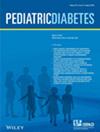Hypoglycemia Awareness Trajectories in Young People with Type 1 Diabetes Using Flash Glucose Monitoring
IF 3.9
3区 医学
Q2 ENDOCRINOLOGY & METABOLISM
引用次数: 0
Abstract
Aim. The trajectories of the hypoglycemia awareness status (HAS) have not yet been studied in children and adolescents with Type 1 diabetes (T1D). Methods. This 2-year follow-up study included children and adolescents with T1D aged 6‒20 years old and using flash glucose monitoring. The HAS of each participant was determined by the Gold score and assessed at three time points, along with clinical data. The trajectories based on HAS progression over time were identified, and a logistic regression analysis was performed to compare their characteristics. Results. Among the 255 participants, we identified four HAS trajectories (T1–T4). T1: normal awareness of hypoglycemia (NAH) maintained over time (n = 82, 29%); T2: NAH recovered during follow-up (n = 40, 18%); T3: impaired awareness of hypoglycemia (IAH) developed during follow-up (n = 28, 12.4%); T4: IAH maintained over time (n = 59, 21%). Sixteen participants (7%) displayed no identifiable trajectory. Participants belonging to the T3 group were younger. Following a specific trajectory defined the risk of developing future severe hypoglycemia. Conclusions. HAS changed in a significant proportion of pediatric people with T1D over time. Participants with a trajectory toward IAH were younger. Frequent HAS assessments may help to improve hypoglycemia risk management, especially in young children with T1D.使用瞬时血糖监测的年轻1型糖尿病患者低血糖意识轨迹
的目标。儿童和青少年1型糖尿病(T1D)的低血糖意识状态(HAS)的发展轨迹尚未被研究。方法。这项为期2年的随访研究包括6-20岁的T1D儿童和青少年,并使用瞬时血糖监测。每个参与者的HAS由Gold评分确定,并在三个时间点与临床数据一起评估。确定了基于HAS随时间进展的轨迹,并进行了逻辑回归分析以比较其特征。结果。在255名参与者中,我们确定了四种HAS轨迹(T1-T4)。T1:长期维持正常的低血糖意识(n = 82,29 %);T2:随访期间NAH恢复(n = 40, 18%);T3:随访期间低血糖意识受损(n = 28, 12.4%);T4: IAH随时间维持(n = 59, 21%)。16名参与者(7%)没有可识别的轨迹。T3组的参与者更年轻。遵循一个特定的轨迹来确定未来发生严重低血糖的风险。结论。随着时间的推移,很大一部分患有T1D的儿童发生了变化。有IAH倾向的参与者更年轻。频繁的HAS评估可能有助于改善低血糖风险管理,特别是在年幼的T1D儿童中。
本文章由计算机程序翻译,如有差异,请以英文原文为准。
求助全文
约1分钟内获得全文
求助全文
来源期刊

Pediatric Diabetes
医学-内分泌学与代谢
CiteScore
6.60
自引率
14.70%
发文量
141
审稿时长
4-8 weeks
期刊介绍:
Pediatric Diabetes is a bi-monthly journal devoted to disseminating new knowledge relating to the epidemiology, etiology, pathogenesis, management, complications and prevention of diabetes in childhood and adolescence. The aim of the journal is to become the leading vehicle for international dissemination of research and practice relating to diabetes in youth. Papers are considered for publication based on the rigor of scientific approach, novelty, and importance for understanding mechanisms involved in the epidemiology and etiology of this disease, especially its molecular, biochemical and physiological aspects. Work relating to the clinical presentation, course, management and outcome of diabetes, including its physical and emotional sequelae, is considered. In vitro studies using animal or human tissues, whole animal and clinical studies in humans are also considered. The journal reviews full-length papers, preliminary communications with important new information, clinical reports, and reviews of major topics. Invited editorials, commentaries, and perspectives are a regular feature. The editors, based in the USA, Europe, and Australasia, maintain regular communications to assure rapid turnaround time of submitted manuscripts.
 求助内容:
求助内容: 应助结果提醒方式:
应助结果提醒方式:


